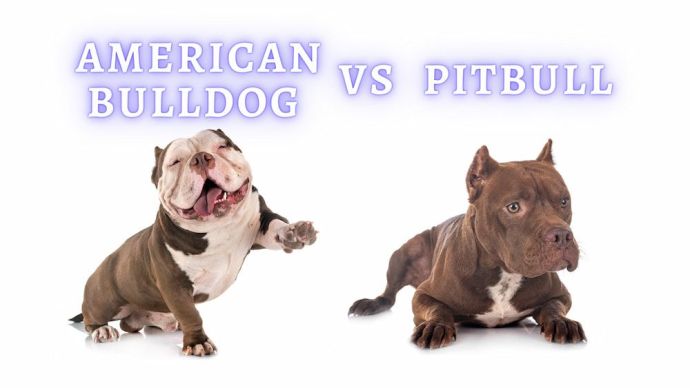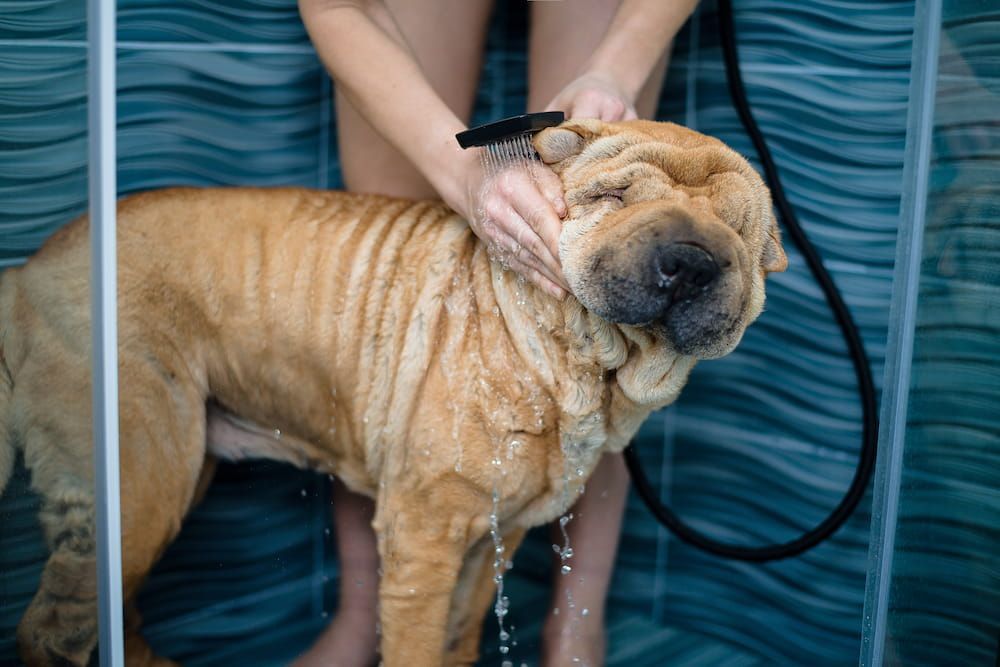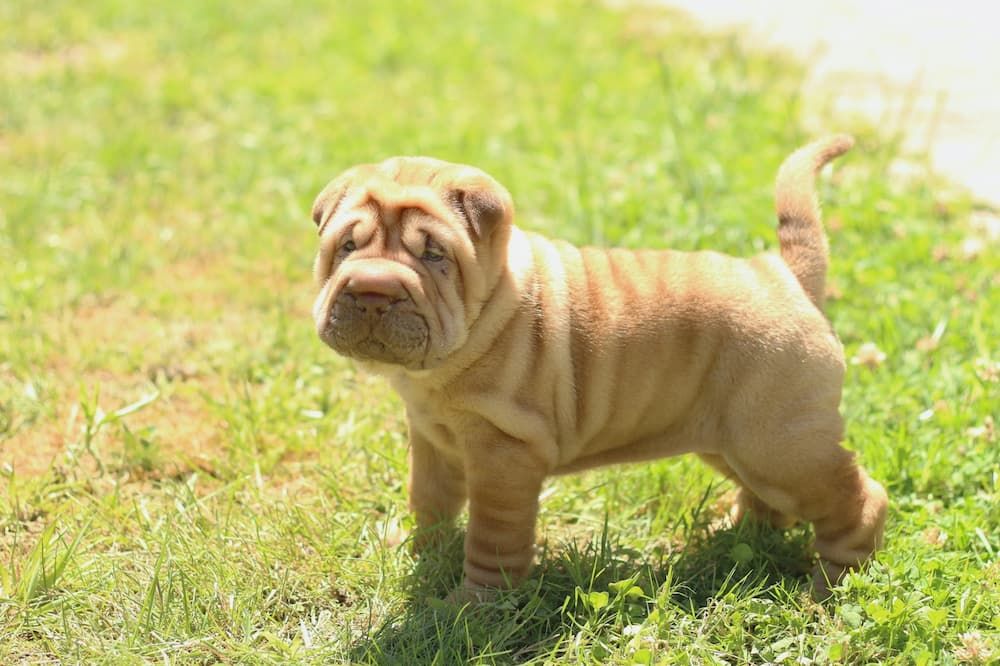Shar-Pei: Chinese Shar-Pei Temperament, Breed History and Care
Written by:
Author: Vicki Smirnova
Vicki Smirnova is a professional writer and editor who adores animals and helps readers get along well with their pets. She has been working in digital media for more than 5 years and has great experience writing content about lifestyle, including pets. Vicki specializes in dog health and nutrition, cat feeding, dog training. She is an aquarium lover and is passionate to write about fish care at home. Also, Vicki headed several websites and worked as a news editor.
View all 244 articlesLearn about our editorial process and veterinary review board.
Viewed: 99
Updated on: 06/27/2023
The Shar-Pei is an ancient breed of hunting and guard dog from China. Distinctive features are large folds of skin and a blue tongue. These are square-shaped, powerful-looking dogs with short loins, good bones, and short coat that is rough to the touch.
Chinese Shar-Pei Breed History
The first information about dogs similar to modern Shar-Pei dates back to 206 BC, the beginning of the Han Dynasty in China. During the heyday of the Han Empire, Shar-Pei was very popular – dog figurines were found in the tombs. At that time, Shar-Pei was mainly used for security purposes. There is an assumption they were much larger at that time.
Later, Shar-Pei became fighting dogs. In Tai Li, near present-day Guangzhou, the peasants used the Shar-Pei’s ancestors to fight. Thick folded skin helped them to escape serious wounds, but these dogs lacked aggressiveness: only by seriously teasing the Shar-Pei could one count on success in battle. Fortunately, the career of Shar-Peis as a battle dog did not last long. The breed was also used to hunt large animals – a wolf, a wild boar, and large cats – and protect livestock from predators.
The Chinese Communists dealt a very strong blow to dogs in the 1940s. They began to consider keeping pets a huge luxury and heavily taxed pet parents. Later, Mao Zedong issued an edict that declared domestic animals “a symbol of the worthlessness of the privileged class” and ordered them to be massacred. Therefore, during the Cultural Revolution, this breed (along with all the others) was almost completely destroyed. By 1950, only a few Shar-Pei were known to exist in Taiwan and Macau.
In 1966, the first Shar-Pei came to the United States through Hong Kong, which aroused great interest among amateur dog breeders. In 1971, they were registered as Chinese fighting dogs. In the early 1970s, a whole campaign was launched to save the breed. Fanciers crossed them with similar dogs, resorted to inbreeding, and selected the most successful ones for breeding work. In 1976, the United States registered the first official standard for the Shar-Pei breed.
Facts about the Shar Pei Dog
- Shar-Pei is translated from Chinese as “sand” or “sand skin.” This is due to the special harsh coat of the dog – rough, prickly, similar to that of a horse, and, like sand, hard to the touch.
- Interestingly, the Shar-Pei breed belongs to the four dog breeds from the so-called “first cluster.” from which all other breeds originated. This was proved in a 2004 study by scientists who compared the Shar-Pei genome with the wolf genome.
- In 2010, scientists also unraveled the mystery of the special folding of the Shar-Pei’s skin. It is associated with a mutation in the HAS2 gene responsible for synthesizing hyaluronic acid.
- Genetics has established that the breed’s age can reach 3 thousand years.
- Shar-Pei’s unusual coat is a strong allergen, so before buying, all family members should interact closely with the dog to identify a possible reaction of the body.
- A Sha- Pei needs an experienced and active owner who can maintain authority in the eyes of the pet.
- The dog is not recommended for families with toddlers but gets along well with older children and teenagers.
- It does not need constant physical activity and is preferably kept at home.
- Early socialization is necessary (possibly with the help of a specialist dog handler) to avoid aggression toward other animals and strangers.
- Unfortunately, Shar-Pei does not live long; the average life expectancy is 8-12 years.
Appearance Shar Pei Dog Breed
Shar-Pei’s appearance is unique and memorable. These are strong, compact, stocky dogs that are proportionately folded.
| Weight | 40-55 pounds |
| Height | 18-20 inches |
| Colors and patterns | Blue, black, chocolate |
| Lifespan | 8-12 years |
| Suitable for | Guard |
This is a medium-sized dog that has a strong physique with a large number of skin folds all over its body. The tail set high and of medium length, is thick and round at the base and rolled into a regular or curved ring over, or to either side, of the back. The ears are small and bent forward, and the eyes are dark, medium-sized, and almond-shaped.
Skin and coat are the hallmarks of this breed. It’s severe wrinkling of the skin is due to a mutation in the HAS2ruen gene, which is responsible for the synthesis of hyaluronic acid (one of the key components of the skin). The Shar-Pei has three main types of coat – horse coat, brush coat, and bear coat. The coat is short, harsh, and bristly without an undercoat, straight and sticking out on the body but more lying on the limbs.
The Shar-Pei has a wide range of colors, divided into two groups. The main color is a black pigment with varying intensity. Among the pigmented colors, several are most prevalent: black, red, cream, and blue.
Personality and Temperament
Shar-Peis are the guardian of the family. They are incredibly open and friendly with loved ones, distinguished by great friendliness and kindness. However, strangers are usually withdrawn and uncommunicative; moreover, if the dog is not socialized enough, it may consider all strangers approaching the owner potentially dangerous. The Shar-Pei is very devoted to its family. These dogs have been used as guard dogs for hundreds of years.
This breed loves children and enjoys spending time with them, playing, and walking. The Shar-Pei copes well with the role of a nanny, and it’s very developed intellect recognizes its own responsibility for his little master.
Despite their obedience and devotion to their owner, these pets have inner pride and independence. Therefore, you need to be able to position yourself as a leader to earn the dog’s respect.
The Shar-Pei gets along well in a city apartment, as he is not inclined to be destructive and make a mess at home from excess energy. Because of this, they need walks and exercise to keep their muscles in good shape.
The Shar-Pei is perfect if you need a watchdog for a private home. However, remember that the breed has a short coat; therefore, they cannot live outside all year round. The Shar-Pei understands its owner very well – often even intuitively. It enjoys spending time with loved ones. You will have to take your pet with you on all trips.
Chinese Shar-Pei Activity Levels and Trainability
Raising and training Shar-Pei takes time and perseverance. These dogs have a highly developed intellect, but they are in no hurry to carry out the commands of a person, almost as if wondering if this is really necessary. Therefore, the owner of the Shar-Pei must be more stubborn than the pet. With due patience, raising a dog to be an obedient and social companion will be possible.
Even though the Shar-Pei is a very loyal dog, they can be a little stubborn; in addition, leadership qualities are required from you. You need to clearly show who, so to speak, is the boss in the house. To do this, if the dog does not obey you, you can take away its favorite toy and not give it back until it learns what is expected. But this must be done with kindness and humor while at the same time being aware of your superiority.
Shar-Peis benefit from early socialization. As a puppy, introduce it to your friends, drive it through the streets where there are many people and dogs, and to the dog playground and the veterinary clinic. It is worth taking along a treat to encourage the pet if it demonstrates the correct behavior in society and does not show aggression or excessive timidity.
Health Problems
Shar-Peis, like all dogs, are prone to various diseases and have a breed predisposition. Very often, there are various skin, eyes, gastrointestinal tract, respiratory, urinary, and immune systems diseases.
- Idiopathic skin mucinosis: This is a disease that is characterized by the appearance of edema due to increased accumulation of mucin.
- Demodicosis. A parasitic disease caused by an intradermal parasite of the genus Demodex. The symptoms noted are alopecia, slight itching, and the appearance of papules.
- Atopic dermatitis. Depending on the allergens causing the hypersensitivity reaction, the disease may be seasonal.
- Primary seborrhea.
- Intertrigo. This disease develops when the skin is damaged from the friction of the folds and subsequent secondary infection with a bacterial or fungal flora.
- Idiopathic megaesophagus. A congenital disease that has a breed predisposition.
- Lymphocytic-plasmacytic enteritis. It occurs in adult dogs and is characterized by intestinal inflammation, in which the cellular infiltrate of its mucous membrane mainly consists of lymphocytes and plasma cells.
- Dysplasia of the hip joints.
- Shar-pei fever. A breed disorder is also known as swollen hock syndrome.
- The curvature of the eyelids. There is also sometimes a prolapse of the third eyelid gland, glaucoma, cataracts, etc.
- Amyloidosis of the kidneys. This disease develops due to a violation of protein-polysaccharide metabolism in the body. As a result, amyloid is deposited in the internal organs, displacing the basic intraorgan elements, which leads to structural and functional disorders in the liver, spleen, gastrointestinal tract, and thyroid gland.
- Primary dyskinesia of the ciliated epithelium. A disease characterized by disruption of the cilia and difficult evacuation of mucus from the respiratory tract.
If you are going to buy a Shar-Pei puppy, remember that to choose one that is good and healthy, you need to collect as much information as possible about its parents. Also, research the dog’s characteristics and personality, how it reacts to children, and try to get to know the puppy personally.
Coat Care and Grooming
The Shar-Pei adult dog is ideal for apartment maintenance. The main thing is twice daily walks for an hour with the opportunity to run and play freely. The Shar-Pei is unpretentious in care, but there are certain nuances that every owner should know.
Use a rubber brush once a week to remove dead hair. Features of bathing a Shar-Pei: the animal is bathed as it gets dirty, but not more than once a month. While bathing, the ears should be carefully closed so water does not get in. Otherwise, it will cause a serious ear infection. Use only hypoallergenic shampoos while bathing, thoroughly wash and rinse each crease after bathing, and dry the hair thoroughly with a hairdryer, straightening the wrinkles to get rid of excess moisture between the folds (a special powder will help, which also eliminates skin irritation).
Otherwise, caring for a Shar-Pei does not differ from the standard care procedures for other dogs – brushing their teeth, wiping their eyes, and trimming their nails. Caution: be more careful when cleaning its ears – this is the weak point of sharpeis.
READ MORE: Best Dog Ear Cleaners (Vet Approved Review)
Diet and Nutrition
Your dog’s diet should provide an optimal balance of all major nutrient groups and always have access to fresh, clean water.
A Shar-Pei needs quality nutrition and adherence to the feeding regimen, as nutrition helps prevent some diseases characteristic of this animal.
The Shar-Pei is prone to obesity, so they should not be overfed, and in case of weight gain, the diet should be reviewed and changed to a lower-calorie food. In 90% of cases, eating leftovers from the owner’s table leads to food allergies. And if you treat a Shar-Pei with canned dog food, it will most likely refuse dry food.
Frequently changing its food adversely affects Chinese shar peis health. Shar-Peis are best suited for hypoallergenic foods, given their greater tendency to have food allergies. Medicated foods should only be given if the doctor has diagnosed the problem and prescribed a special diet.
It is important to regularly assess the body’s condition to keep it in perfect shape. In addition, remember to feed your pet at least twice a day following the nutritional recommendations that come with certain foods.
READ MORE: Why Is My Dog Losing Weight?
Adopt or Buy
Before buying a Shar-Pei, it is worth studying the pedigree and talking with owners, kennel clubs, and breeders. While puppies are most adorable at four weeks old, this is not the right young age. The puppy, which is just starting to take its first steps, requires a lot of attention, including four feedings a day.
At eight weeks, the puppy is already completely independent of the mother; during this period, contact with a person is the best. At this age, a puppy can be taught simple things like responding to its name or walking on a leash. The socialization process is completed at 11-12 weeks, and the puppy is completely ready to move to a new home.
People also ask
Is A Shar-Pei a good family dog?
The Shar-Pei character is proud and independent. Dogs of this breed are very attached to their family. In it, they quickly single out one owner, whom they obey more.
Why is a Shar-Pei difficult?
The Chinese Shar Pei dogs have a rather complex character. Its main qualities are nobility, tact, devotion, and balance. In the family circle, the dog is affectionate and friendly, but it is arrogant (but not aggressive) in relation to strangers.
What two breeds make a Shar-Pei?
The Shar-Pei is descended from either smooth-coated Chow Chows or ancient Mastiffs. Chinese Shar-Pei and Chow Chows existed simultaneously, and similarities are noted in the build and appearance of these breeds.
Why are Shar-Peis so rare?
In the middle of the 20th century, Shar-Pei was almost completely exterminated by the communist government, which did not approve of keeping dogs as pets. However, Hong Kong and Taiwan breeders managed to save the breed and eventually restore its numbers.
 Dog Breeds Bernedoodle: Bernese Mountain Dog and Poodle Mix Personality, Temperament, Grooming and Adoption
Dog Breeds Bernedoodle: Bernese Mountain Dog and Poodle Mix Personality, Temperament, Grooming and Adoption - 639
- 0
 Dog Breeds American Bulldog vs Pitbull: American Bulldog and Pitbull Terrier Differences and Similarities
Dog Breeds American Bulldog vs Pitbull: American Bulldog and Pitbull Terrier Differences and Similarities - 877
- 0
 Dog Breeds Rottweiler: Rottweiler Dog Breed History, Personality and Health Care
Dog Breeds Rottweiler: Rottweiler Dog Breed History, Personality and Health Care - 149
- 0
 Dog Veterinary Tips Why is my Dog throwing up: Causes and Preventing (Veterinary Advice)
Dog Veterinary Tips Why is my Dog throwing up: Causes and Preventing (Veterinary Advice) - 23424
- 5
 Dog Care Why Is My Dog Bleeding From Its Butt? Causes and treatment of rectal bleeding in the dog
Dog Care Why Is My Dog Bleeding From Its Butt? Causes and treatment of rectal bleeding in the dog - 22076
- 0
 Dog Care My Dog Keeps Scratching His Mouth: Reasons Why Your Dog Scratching Face
Dog Care My Dog Keeps Scratching His Mouth: Reasons Why Your Dog Scratching Face - 17561
- 1
























